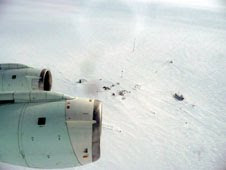 The Arctic remains in the mind a pristine wonderland. The landmasses that jut into the Arctic Circle are covered by tundra and primeval forest; the pole is covered in ice. The whole environment seems detached from human influence entirely. But the scientific record tells a different story.
The Arctic remains in the mind a pristine wonderland. The landmasses that jut into the Arctic Circle are covered by tundra and primeval forest; the pole is covered in ice. The whole environment seems detached from human influence entirely. But the scientific record tells a different story.A months-long airborne campaign in 2008 gave scientists a new look at how everyday human behaviors in Europe, North America and Asia are affecting the Arctic, the most rapidly changing region on Earth and a major regulator of the planet's climate. The data show human fingerprints all over the Arctic in the form of polluted exhaust from factories and smoke from fires often set by human hands. Observations from the ground have long recorded some of this impact, and satellites in low-earth orbit provide a different view, but scientists had not undertaken a detailed, airborne study of this magnitude in years.
The mission provided a new view of how pollution from industrializing Asian countries influences the Arctic. Ground sensors have long detected the regular, low-altitude movement of polluted air masses from Europe to the Arctic. Because of the colder temperatures in the countries of the pollution's origin, the plumes of carbon dioxide, carbon monoxide and other warming-related gases do not rise high in the atmosphere. On the contrary, pollution from warmer regions in Asia has apparently been moving to altitudes too high for ground instruments to observe well. The airborne instruments provided invaluable measurements of the extent of this pollution, said Daniel Jacob, a Harvard University atmospheric scientist and both mission scientist and co-principal investigator for NASA’s Arctic Composition of the Troposphere from Aircraft and Satellites (ARCTAS) mission.
"With Asian pollution, there's a relatively warm ocean immediately downwind of a fairly cold continent, so you have interesting storm tracks that lift pollution and transport it at higher altitudes," Jacob said. "It's certainly a much larger influence on Arctic haze than what had been traditionally ascribed."
Now that researchers have had some time to sift through the data collected, Jacob said the value of these observations is coming in to focus. Major airborne campaigns like this are rare, so almost any study of the Arctic atmosphere in coming years will draw on ARCTAS.
"We're getting to the point where results from ARCTAS are getting into climate models. We’re able to test different models of snow albedoes, and we've been able to introduce some corrections," Jacob said. "From the standpoint of the Asian pollution influence, if you want to claim Asia has a certain influence, you better check it against the ARCTAS results."
While factories, power plants and cars on the highway provide a 365-day-a-year source of pollution, the Arctic flights revealed insights into a more cyclical source of emissions: fires in boreal forests and from agricultural burning as far away as Kazakhstan. In concert with NASA, NOAA sponsored spring flights as part of a field study called Aerosols, Radiation and Cloud Processes affecting Arctic Climate (ARCPAC). These flights observed an unusually active spring fire season. Even if the data collected was somewhat anomalous, scientists say it has provided great insight into fire and smoke influence on the Arctic. In addition, there is some evidence that as the Arctic warms and dries out, there is more fuel for these fires.
"We expected to see pollution. But it turns out there's a seasonal cycle to fires, and there’s a springtime peak and summertime peak," said Chuck Brock, ARCPAC project scientist. "I don't think we appreciated that these fires in Siberia and in southern Russia could be so dominant and important in the Arctic. So, is 2008 representative or is it an unusual year? But every year there is this peak, and every year this smoke gets carried to the Arctic."
Brock said the wealth of data will be important in studying the link between smoke and cloud formation and the repercussions of this link. For instance, could there be an impact on snowmelt -- through aerosol-related warming -- if the spring fire season inches up by even a week or two?
 The campaigns also provided the opportunity to create a sharper picture of several specific emission sources of greenhouse gases that find their way to the Arctic. Scientists focused on emissions from the oil and gas industry in Prudhoe Bay, Alaska and the natural methane emissions from the massive wetlands near Hudson Bay in Canada. These are two examples of the many variables that need to be accurately characterized in order for scientists to understand what is driving Arctic warming.
The campaigns also provided the opportunity to create a sharper picture of several specific emission sources of greenhouse gases that find their way to the Arctic. Scientists focused on emissions from the oil and gas industry in Prudhoe Bay, Alaska and the natural methane emissions from the massive wetlands near Hudson Bay in Canada. These are two examples of the many variables that need to be accurately characterized in order for scientists to understand what is driving Arctic warming.It is the rarity of these measurements that makes them important to future study of the Arctic climate, said Jim Crawford, a research scientist at NASA's Langley Research Center and the ARCTAS program manager during the campaign. The data gathered will allow scientists to better interpret satellite observations and better simulate how industrial pollution and wildfire smoke affect the Arctic.
"For scientists interested in studying the role of changing atmospheric composition on climate, the ARCTAS data will represent the best and often only detailed information available for this poorly characterized region," Crawford said.
Related Links:
› ARCTAS Mission
› NASA's Earth Science Project Office
View this site car shipping car transport auto transport auto shipping




No comments:
Post a Comment